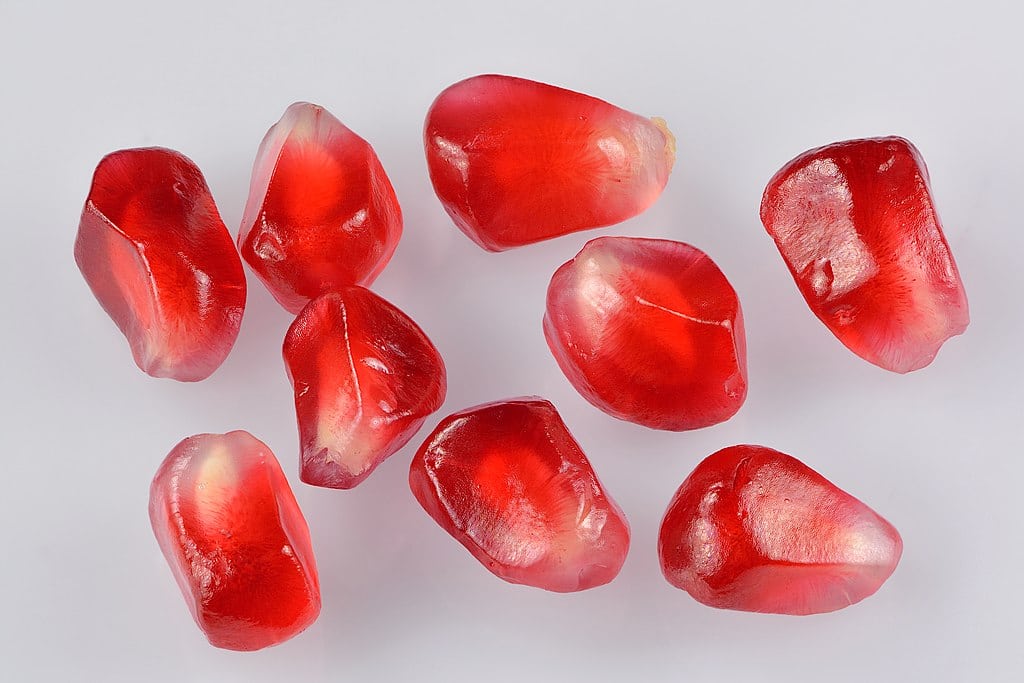Pomegranate:
What is it?, history, cultivation, nutritional value, uses, recipes, and more...
The pomegranate is the fruit of the pomegranate tree (Punica granatum), a small tree that can reach up to 5 meters in height and belongs to the family Punicaceae. It grows in tropical and subtropical regions.
Índice
What is a Pomegranate?
The pomegranate is the fleshy fruit of the pomegranate tree, Punica granatum, a species of the Lythraceae family native to the region from Iran to the Himalayas. It has been cultivated since ancient times throughout the Mediterranean basin.
The pomegranate tree can reach a height of up to 5 meters. It can grow as a deciduous shrub, is somewhat spiny, and highly branched. Its trunk is straight with cracked bark, and it has opposite branches.
The leaves are lanceolate to oblong, opposite or subopposite, measuring between 1.5-7 by 0.8-2 cm. They are glossy on the upper surface, hairless, and yellowish-green. The pomegranate flowers measure between 3 and 4 cm in diameter, with obovate, corrugated, deciduous petals of intense red color, measuring 2-2.5 by 1-1.5 cm.
The fruit itself, the pomegranate, has a round shape and is slightly larger than an apple. It has a thick skin that can be scarlet or golden in color. Inside, it contains a large number of red seeds separated by membranous partitions. These seeds are immersed in a juicy pulp with a sweet and tangy flavor.
History of the Pomegranate
It is believed that the pomegranate originated in Persia, present-day Islamic Republic of Iran, in the early years of the Neolithic period. Its cultivation spread early on, with the Phoenicians exporting it to the western Mediterranean region. This region included Carthage, a city that became a major planter of pomegranate trees and exporter of their fruits.
In ancient Greece, Hippocrates recommended pomegranate juice for fever and as a tonic against illness, while the Babylonians believed that chewing its seeds before battles made them invincible.
This fruit was planted in the Hanging Gardens of Babylon and is sculpted in Egyptian reliefs, where it was cultivated since the 18th Dynasty, in the early 2nd century BC. During this period, its fruits were already used to make a juice or light wine with a raspberry-like flavor, highly appreciated. It was the Arabs who introduced the pomegranate to Spain, from where it was exported to America after the conquest, quickly spreading throughout tropical and subtropical areas from California to Chile.
Even in the Bible, multiple references to this fruit can be found, always in its defense.
Historically, many cultures have considered the pomegranate as a symbol of love, fertility, and prosperity:
According to Greek mythology, the first pomegranate tree was planted by Aphrodite, the goddess of love and beauty. On the other hand, the god of the Underworld, Hades, offered this fruit to the beautiful Persephone to seduce her.
In Java, it is associated with certain rituals accompanying pregnancy.
According to Shakespeare, Romeo hid under a pomegranate tree to serenade Juliet.
In China, it is customary to offer a pomegranate to newlyweds as a sign of abundant offspring (the color red is considered auspicious in Chinese tradition).
Due to its abundance of seeds, it was considered a symbol of fertility and was associated with the goddesses Hera, Demeter, and Aphrodite in ancient times.
In Rome, it was common for brides to wear a headdress made of pomegranate branches.
This fruit is also present in numerous national symbols and rituals. It appears on the coat of arms of Colombia and on the coat of arms of its capital, Bogotá. Since 1492, it has been part of the coat of arms of Spain and the city of Granada. It is also present on the coat of arms of the city of Tacna in Peru. Additionally, it is found in Christian religious motifs, especially in the vestments of priests for religious rituals. It is one of the symbols of Rosh Hashanah (Jewish New Year). In Islam, it is considered one of the trees of Paradise. It also appears in some religious-themed paintings by Sandro Botticelli and Leonardo da Vinci.
Furthermore, in Freemasonry, it represents the unity of the masons.

Common name of Pomegranate
| Castellano | agrauz, agrios, albar, almegranas, alvarés, balaustia, balaustra, balaustria, balaustrias, balustia, cagines, de pasa, de piñón tierno, engranao, granada, granada agria, granada agria colorada, granada agridulce, granada albar, granada cagina, granada de viuda, granada diente de perro, granada dulce, granada dulce sin piñón, granada fina, granada frailera, granada herreña, granada miniatura, granada mollar sin hueso, granada silvestre, granada ácida, granadas, granado, granado agrio, granado borde, granado bravío, granado común, granado loco, granado silvestre, granao, graná, granás, magrano, manglanera, manglano, mangranero, mengranera, mengranero, migraña, milgrano, minglanera, mingranera, mingrano, mollar, piñonenca, román. |
| Alemán | Granatapfel |
| Francés | Grenadier |
| Inglés | Pomegranate |
Scientific name of Pomegranate
Punica granatum
Taxonomy of Pomegranate
| Reino | Plantae |
| División | Magnoliophyta |
| Clase | Magnoliopsida |
| Orden | Myrtales |
| Familia | Lythraceae |
| Subfamilia | Punicoideae |
| Tribu | Chenopodieae |
| Género | Punica |
| Especie | Punica granatum |
Synonymy of Pomegranate
Punica florida Salisb.
Punica grandiflora hort. ex Steud.
Punica nana L.
Punica spinosa Lam.
Punica granatum var. granatum L.
Punica granatum var. sativum K.Malý
Rhoea punica St.-Lag.
Granatum puniceum St.-Lag
Etymology of Pomegranate
The generic name, Punica, comes from the Latin word pūnĭcum, referring to the Phoenicians, who were active promoters of its cultivation.
Granatum, on the other hand, derives from the Latin adjective grānātus, which means ‘with abundant grains.’ Other sources believe that this name comes from Arabic (gar-anat, “hill of pilgrims”).
In ancient Rome, theterm for the pomegranate tree was “punicum arbos” (Punic tree), and the fruit was called “malum granatum” (grained apple) or “punicum malum” (Punic apple). In the mid-1st century AD, Pliny the Elder mentioned in his book “Naturalis Historia”: “In Africa, near Carthage, there is the Punic apple that some call granatum.”
Cultivation, distribution, and habitat of the Pomegranate
- Habitat
- Distribution
- Cultivation
Habitat of the Pomegranate
Native to the region from Iran to the Himalayas, it spread to central and southern India in the 1st century AD and has been extensively cultivated in Southeast Asia, Malaysia, the West Indies, and tropical Africa. It is naturalized throughout the Mediterranean basin and introduced in South America, Mexico, and Australia, where it is grown in temperate and subtropical areas.
It is dispersed mainly in the eastern and southern Iberian Peninsula and the Balearic Islands. It is also found in the Canary Islands, where it grows spontaneously on embankments, ditches, and hedges from sea level up to 1,100 meters above sea level.
In terms of cultivation, it adapts to all types of soils, although it thrives in deep, alkaline, light, permeable, and fresh soils.
It tolerates drought, salinity, and low temperatures quite well (it can withstand temperatures below -7ºC in winter) as long as they do not regularly drop below 0ºC. It grows in a subtropical and even tropical climate, with its ripening period coinciding with high temperatures.
In Peru, pomegranate cultivation is driven by commercial export purposes. In recent years, there has been significant growth in the export of this fruit, reaching 27,199 tons sent abroad in the last annual campaign. Pomegranates produced in Peru are already positioned in 31 international markets, including the Netherlands, Russia, Canada, England, the United Kingdom, and Egypt.
Distribution of the Pomegranate
Pomegranate Cultivation
Geographical distribution of the Pomegranate

Lima, Ica, Ancash, La Libertad
Availability of Pomegranate
- February, March, April, May, June
Varieties of Pomegranate
Pomegranate varieties are classified as Sweet, Sweet-Sour, or Sour, and their notable indices are Acidity and Maturity Index (SS/A).
-
Among its varieties are:
Mollar de Elche, Mollar Valenciana, Wonderful variety, 116 Acco, Kamel variety, Tendral, Dholka, Bhagwada, Paper Shell, Hershkovitz, Pink Full, Big Full, Shany, Emek, Hicaz, Ahmar, Aswad, Halwa, Red Loufrani, Malassi, Rass, Baghl.
Nutritional Value of Pomegranate
Pomegranate is known to contain antioxidants that can help reduce cholesterol levels and prevent heart diseases. Antioxidants also help oxygenate skin cells and slow down the aging process.
Its use has been studied in the prevention of various types of cancers, cardiovascular diseases, osteoarthritis, and rheumatoid arthritis. It is also believed to be beneficial in combating Alzheimer’s disease.
Pomegranates contain plant compounds with significant antibacterial and antifungal qualities that prevent infections in the body. Due to its pectin content, it aids in the natural detoxification of the body.
It is a fruit with very low caloric value and contains dietary nitrates that delay the onset of physical fatigue and reduce pain after intense physical activity, making it optimal for improving physical performance and in weight loss diets.
It is also notable for its mineral content, especially potassium, necessary for the transmission and generation of nerve impulses, normal muscle activity, and the elimination of water and salts through the kidneys. It provides vitamin C, which is involved in collagen formation, bone and tooth health, red blood cell production, and enhances iron absorption while strengthening the body against infections. Its manganese content is useful for treating enzymatic metabolism disorders.
Likewise, pomegranate has been proven to have beneficial properties related to the reproductive system. It has a high content of plant estrogens, which are closely related to fertility, and is considered a natural aphrodisiac, increasing testosterone levels by up to 30%, the hormone that regulates sexual desire in both men and women.
In women with Polycystic Ovary Syndrome (PCOS), the intake of pomegranate helps improve insulin resistance, testosterone levels, Body Mass Index (BMI), body weight, and abdominal circumference.
Health Benefits of Pomegranate
Pomegranate stands out primarily for its powerful antioxidant properties. Additionally, it is a fruit rich in minerals and vitamins, especially potassium, phosphorus, manganese, calcium, iron, magnesium, and vitamin C.
Contraindications or Side Effects
Despite its undeniable benefits, pomegranate has contraindications that should be taken into account:
Its consumption may enhance the side effects of certain medications, so it is recommended to consult a doctor if you want to include it regularly in your diet.
If consumed excessively and if blood pressure is already low, it may cause hypotension or a sudden drop in blood pressure due to its blood pressure-lowering properties.
Individuals with liver disorders should consult a doctor before consuming it, as the enzymes present in pomegranate could interfere with liver function.
Excessive consumption may cause stomach discomfort such as nausea, vomiting, diarrhea, and abdominal pain due to its high fiber content.
Its consumption is not recommended for people undergoing medical treatment with anticoagulants, as it may interfere with the effect of these medications.
| 10 Porciones por Kilogramo | |
| Tamaño de porción | 100g |
| Cantidad por porción Calorías |
66 |
| Cantidad por 100g | |
| Energía | 277 kJ |
| Grasa Total | 0.1 g |
| Sodio | ● |
| Carbohidratos totales | 18.3 g |
| Carbohidratos disponibles | 17.7 g |
| Fibra Dietaria | 0.6 g |
| Proteínas | 0.5 g |
| Calcio | 10 mg |
| Fósforo | 38 mg |
| Zinc | 0.12 mg |
| Hierro | 0.30 mg |
| Potasio | ● |
| Agua | 80.0 g |
| Cenizas | 1.1 g |
| Vitamina A | 5 μg |
| Tiamina (B1) | 0.09 mg |
| Riboflavina (B2) | 0.04 mg |
| Niacina (B3) | 1.56 mg |
| Vitamina C | 5.20 mg |
| Acido Fólico (B9) | ● |
| β-Caroteno | ● |
| Fuente: Tablas peruanas de composición de alimentos – Centro Nacional de Alimentación y Nutrición – Ministerio de Salud – Perú | |
Derived Products and Ways of Consuming Pomegranate
Uses of Pomegranate
The use of pomegranate is not limited to culinary purposes. It also stands out for its medicinal supplementation and its use in the pharmaceutical and cosmetic industries.
- Culinary
- Medicinal
- Industrial
- Ritual
Culinary Uses of Pomegranate
The fruit can be consumed fresh, but it can also be used to make juices, beverages, infusions, yogurts, ice creams, salads, and as an ingredient in cooked dishes.
The seeds are increasingly used in the production of preserves, jellies, jams, syrups, ice creams, among others. It is also a widely used ingredient in pastry, where it can be used as an ingredient or as toppings for cheesecakes, mousses, and other fresh tarts.
However, it is not limited to sweet recipes. It is frequently used to create flavor contrasts and is employed in the preparation of savory snacks, for example, with aged cheeses, and mixed salads that include vegetables and legumes.
An important derivative of the pomegranate is grenadine, a syrup obtained from its juice, highly valued in cocktails and pastry, although it can also be consumed as a refreshing drink when diluted in water.
Pomegranate can even be dried and used as a seasoning in the preparation of various dishes.
To choose a pomegranate, it is advisable to select a large and heavy fruit with thin, smooth, and shiny skin, free from marks. It is said that the fruit is ripe when it emits a metallic sound when pressed lightly.
This fruit can be stored perfectly at room temperature, although it can be frozen and stored for a maximum of six months.
Medicinal Uses of Pomegranate
Pomegranate is considered a superfood because it is rich in antioxidants and contains potassium, calcium, magnesium, and vitamin C.
Recent studies suggest that consuming pomegranates could have positive effects on cardiovascular health and the prevention of certain types of cancer. It also contains the precursor of urolithin A, an anti-aging substance that could increase muscle endurance.
Pomegranate helps relieve persistent cough and is useful in cases of fever, diarrhea, colic, and can also serve as a vermifuge (a property that eliminates intestinal parasites).
Additionally, pomegranate increases testosterone levels. In a study, daily consumption of pomegranate increased facial hair in men and helped strengthen bones and muscles in women. Other positive effects of increased testosterone include improved mood and memory, reduced stress hormone (cortisol), and increased sexual desire in both men and women.
Furthermore, pomegranate helps alleviate symptoms of stomach disorders, osteoarthritis, and conjunctivitis, while having astringent and anti-inflammatory properties in the mucous membranes of the digestive tract.
Due to its low calorie content, it is suitable for those following a weight loss diet and for people with diabetes.
Industrial Uses of Pomegranate
Pomegranate is widely marketed as a bonsai tree due to its beautiful flowers and the twisted trunks that older specimens develop. Additionally, its juice is used as a natural dye in factories producing non-synthetic products.
This fruit is increasingly used by the food industry in various forms, such as jams and preserves, or as dietary supplements due to its excellent antioxidant properties. It is also found as syrup, jellies, or juice concentrates.
Due to its regenerative and antioxidant properties, it is increasingly used by the cosmetic industry in the production of creams, oils, serums, among others.
In Peru, the increase in pomegranate exports has led to the expansion of cultivated areas dedicated to its cultivation and the increase in the varieties grown to enhance the competitiveness of our supply.



